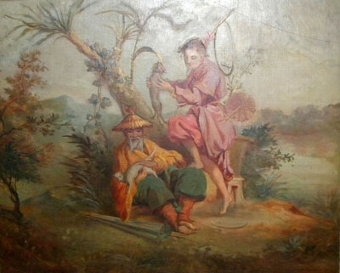The medieval Cathedral of Our Lady of Chartres, (French: Cath?drale Notre-Dame de Chartres), a Latin Rite Catholic cathedral located in Chartres, about 80 kilometres (50 mi) southwest of Paris, is considered one of the finest examples of the French High Gothic style. The current cathedral, mostly constructed between 1193 and 1250, is one of at least five that have occupied the site since the town became a bishopric in the 4th century. What makes the cathedral special from an art historical viewpoint is its exceptional state of preservation. The majority of the original stained glass windows survive intact, while the architecture has seen only minor changes since the early 13th century. The building''s exterior is dominated by heavy flying buttresses which allowed the architects to increase the window size significantly, while the west end is dominated by two contrasting spires ? one, a 105 metre (349 ft) plain pyramid dating from the 1140s, and the other a 113 metre (377 ft) tall early 16th century Flamboyant spire on top of an older tower. Equally notable are the three great facades, each adorned with hundreds of sculpted figures illustrating key theological themes and narratives.
Since at least the 12th century the cathedral has been an important destination for travellers - and remains so to this day, attracting large numbers of Christian pilgrims, many of whom come to venerate its famous relic, the Sancta Camisa, said to be the tunic worn by the Virgin Mary at Christ''s birth. As with any medieval bishopric, Chartres Cathedral was the most important building in the town - the centre of its economy, its most famous landmark and the focal point of many activities that in modern towns are provided for by specialised civic buildings. In the Middle Ages, the cathedral functioned as a kind of marketplace, with different commercial activities centred around the different portals, particularly during the regular fairs. Textiles were sold around the north transept, while meat, vegetables and fuel sellers congregated around the south porch. Money-changers (an essential service at a time when each town or region had its own currency) had their benches, or banques, near the west portals and also in the nave itself. Wine sellers plied their trade in the nave, although occasional 13th century ordinances survive which record them being temporarily banished to the crypt to minimise disturbances. Workers of various professions gathered in particular locations around the cathedral awaiting offers of work. Although the town of Chartres was under the judicial and tax authority of the Counts of Blois, the area immediately surrounding the cathedral, known as the clo?tre, was in effect a free-trade zone governed by the church authorities, who were entitled to the taxes from all commercial activity taking place there. As well as greatly increasing the cathedral''s income, throughout the 12th and 13th centuries this led to regular disputes, often violent, between the bishops, the chapter and the civic authorities - particularly when serfs belonging to the counts transferred their trade (and taxes) to the cathedral. In 1258, after a series of bloody riots instigated by the count''s officials, the chapter finally gained permission from the King to seal off the area of the clo?tre and lock the gates each night.
Chartres is a town and commune and capital of the Eure-et-Loir department in north-central France. It is located 96 km (60 mi) southwest of Paris. Chartres was one of the principal towns of the Carnutes, and by the Romans was called Autricum, from the river Autura (Eure), and afterwards civitas Carnutum. The name "Chartres" derives from "Carnutes". It was burnt by the Normans in 858, and unsuccessfully besieged by them in 911.During the Middle Ages it was the chief town of Beauce, and gave its name to a countship which was held by the counts of Blois and Champagne and afterwards by the house of Ch?tillon, a member of which in 1286 sold it to the crown. It was raised to the rank of a duchy in 1528 by Francis I. After the time of Louis XIV the title of duke of Chartres was hereditary in the family of Orl?ans.In 1417 it fell into the hands of the English, from whom it was recovered in 1432. It became seat of a Duchy in 1528. During the Wars of Religion, it was attacked unsuccessfully by the Protestants in 1568, and was taken in 1591 by Henry IV, who was crowned there three years afterwards.In the Franco-Prussian War it was seized by the Germans on 2 October 1870, and continued during the rest of the Campaign to be an important centre of operations.The city suffered heavy damage by bombing in the course of World War II, but the Cathedral of Chartres was spared by an American Army officer who challenged the order to destroy it. Colonel Welborn Barton Griffith, Jr. questioned the strategy of destroying the cathedral and volunteered to go behind enemy lines to find out whether the German Army was occupying the cathedral and using it as an observation post. With a single enlisted soldier to assist, Col. Griffith proceeded to the cathedral and confirmed the Germans were not using it. After he returned from his reconnaissance, he reported that the cathedral was clear of enemy troops. The order to destroy the cathedral was withdrawn and the Allies later liberated the area. Col. Griffith was killed in action on August 16, 1944 in the town of Leves, near Chartres. Following deep reconnaissance missions in the region by the 3rd Cavalry Group and units of the 1139 Engineer Combat Group, and after heavy fighting in and around the city, Chartres was liberated, on 18 August 1944, by the U.S. 5th Infantry and the 7th Armored Divisions belonging to the XX Corps of the 3rd US Army commanded by General George S. Patton. The town is best known for the Cathedral of Chartres (French: Cath?drale Notre-Dame de Chartres), widely considered to be the finest Gothic cathedral in France. Its historical and cultural importance is recognized by its inclusion on the UNESCO list of World Heritage Sites. Its construction started in 1205, following the destruction of the old cathedral of Chartres. Construction took 66 years. The abbey church of St.Pierre, dating chiefly from the 13th century, contains, besides some fine stained glass, twelve representations of the apostles in enamel, created about 1547 by L?onard Limosin. Of the other churches of Chartres also noteworthy are St Aignan (13th, 16th and 17th centuries) and St Martin-au-Val (12th century).
John Louis Petit was born at Ashton-under-Lyne, Lancashire, son of John Hayes Petit. He was educated at Eton, and contributed to the "Etonian". He was elected to a scholarship at Trinity College Cambridge in 1822, graduated BA in 1823 and MA in 1826, and on 21st June 1850 he was admitted "ad eundem" at Oxford. He took holy orders in 1824, but undertook no parochial work.
Petit showed a taste for sketching in early years. His favourite subject was old churches, and a great part of his life was spent in visiting and sketching them. In 1839 he made his first extensive tour of the continent. The results appeared in his "Remarks on Church Architectire" (1841, 2 vols which had illustratuions. It was followed in 1846 by "Remarks on Church Architectural Character" Royal folio format.In the same year Petit published a lecture which he had delivered on 24th Feb 1846 to the Oxford Society for promoting the study of Gothic Architecture, under the title "Remarks on the Principles of Gothic Architecture as applied to ordinary Parish Churches". It was succeeded by "Architectire of Tewksbury Abbey Church". Royal svo 1846. " Architectural notes in the neighbourhood of Cheltenham"and "Remarks on Wimborne Minster", 1847. "Remarks on Southwell Minster". With numerous good illustrations. 1848. "Architectural Notices relating to Churches in Gloucestershire and Susse". 1849. "Architectural Notices of the Curious Church of Gillingham.Norfolk". And an "Account of Sherborne Minster". 1850. In 1852 Petit published an account of Brinkburn Priory".
In 1854 appeared Petit''s principal work. "Architectural Studies in France", imperial SVO. It was beautifully illustrated with fine woodcuts and facsimiles of anastic drawings by the author and his companion, Professor Delamotte. It showed much learningand observation, and threw light upon the formation of Gothic in France, and on the differences between English and French Gothic. A new edition , revised by Edward Bell, FSA, with introduction, notes and index, appeared in 1890. The text remained unaltered but the illustrations were reduced in size, and a few added from Petit''s unused woodcuts. In 1864-65 he travelled in the East and executed some striking drawings. He died in Lichfield on 2 Dec 1868, from a cold caught while sketching and was buried in St Micheal''s Churchyard. Petit was the founder of the British Archealogical Institute at Cambridge in 1844. He was also FSA, an honoury member of the Institute of British Architects, and a governor of Christ''s hospital.
Antiques.co.uk Ref: 54QPJTU2
- Materials:
- Pencil and Watercolour














